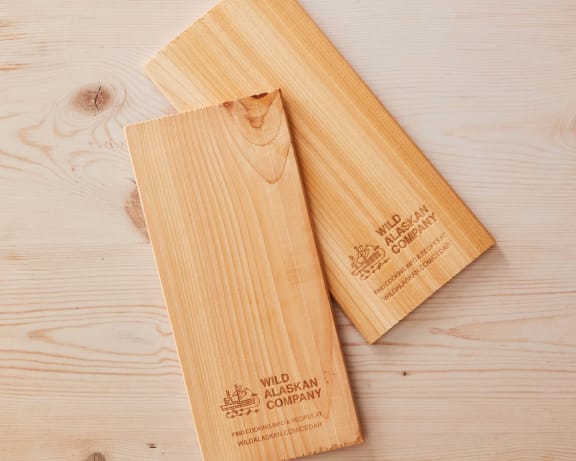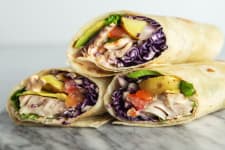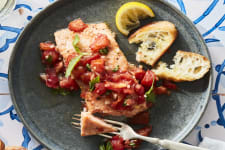
How to Grill Wild Salmon: Cooking Tips and Tricks
June 19th, 2018Tips & Tricks to Master the Ultimate Summertime Food Hack
With warmer weather comes al fresco dining, and there's nothing more satisfying than grilled wild salmon from your own backyard. Need a quick primer on how to grill wild salmon? Here’s how, from grill temperature for salmon to the best salmon for the grill.
How to Grill Wild Salmon: Easy Tips and Tricks
What’s the Best Type of Salmon for Grilling
Sockeye salmon from Alaska is a great choice for grilling. This type of Alaskan salmon has a robust and complex flavor and, sockeye is packed with omega-3s. Its rich flavor complex makes it perfect for grilling and the meaty texture gives it a bit more bite compared to leaner types of fish.

How to Prep Salmon for the Grill
Before you grill salmon, you’re going to want to pat the fillets dry to ensure that there is no excess moisture. You can use a paper towel or clean kitchen towel to do this. Then coat with your favorite cooking oil. We recomend an oil that has a high heat tolerance like avocado. Top with your favorite seasoning; it can be as simple as salt, pepper, and lemon — or go nuts with some of your favorite bbq seasoning and sauces!
Use a Natural or Foil Barrier for Grilling
By using salmon fillets, you already have a built in advantage: the skin. Salmon skin acts as a natural barrier between the meat and the grill so the meat doesn’t burn. If you are using a salmon steak or some other cut of fish without skin, it’s a good idea to use some aluminum foil to create a layer between the fish and the grill. You can also sprinkle some kosher salt on the skin side of the fish to be doubly sure that it won’t stick.
Create a Packet for Moisture Retention
Instead of simply laying the fillet skin-side down on a piece of tin foil, you can surround it in a tin foil pouch in order to keep the salmon’s natural juices close. The aluminum foil pouch also helps if you plan on brushing or drizzling your wild salmon fillets in extra virgin olive oil and lemon juice. This type of cooking is called en papillote, and if you haven't heard, it's one of our favorites because it seals in flavor and moisture.
Check out more tips to keep salmon from sticking to the grill.
Consider Grilling on a Cedar Plank

Cedar planks have been getting more popular in recent years, and for good reason, too. Grilling salmon on a cedar plank is a great alternative to the foil pouch method. It helps lock in moisture and imbues the salmon with a rich cedar flavor.
The surface area of the plank can give you enough space to grill vegetables, too, all while minimizing the amount of oil you'd normally have to use. To do this, all you need are cedar planks which you can easily find in most grocery stores or online shops. It's important to soak the planks in water for up to 12 hours before grilling. When you're preparing the salmon, place it skin side down and drizzle in marinade, olive oil or lemon juice and sprinkle sea salt depending on your recipe. Grilling with cedar planks elevates any fish, and looks perfectly rustic and special when serving.
What Type of Grill Is Best for Grilling Wild Salmon
Either a gas or a charcoal grill will work perfectly for cooking wild salmon. If you use a gas grill, you'll have a bit more control over your temperature. Yet, a natural charcoal provides a special smoky flavor that is hard to find elsewhere.
If you're using a charcoal grill, be sure to use natural charcoal to avoid added chemicals. You’ll need a “tower” to start the charcoal. Before you place salmon on the grill, put some newspaper at the bottom of the tower and some charcoal on top of it, light it up, and in no time you’ll have some embers to cook your salmon over.
How Long Is the Grill Time
Generally, you're looking at a 6 to 10 minute cook time assuming the fillet is about an inch thick. Sockeye and coho will cook quicker than a fattier species like king. You can always take its internal temperature if you have an instant read thermometer handy. Aim for an internal temperature of 120F before checking for doneness by testing the flakiness. When salmon is done, it will flake easily with a fork.
The best part is that keeping the grill lid on retains enough high heat that eliminates the need to flip the salmon. Just let the ambient heat cook the top, while the center cooks up from the bottom.
When done, transfer salmon to a serving dish using a large spatula to ensure the salmon doesn't fall apart. If you'd like, this is when removing the skin of the cooked fillet will be perfectly easy, but don't count out the skin — it's one of the most nutritious parts of the fish.
Recipes to Try with Grilled Salmon
A simple, grilled fillet of salmon is the start of this summer salad with grilled mango. Or, consider using a Moroccan spice blend on sockeye for a smoky take on grilled salmon. A fresh, acidic sauce like escabeche is also a great topping for grilled salmon.
For more inspiration, explore more grilled salmon recipes on the blog.





